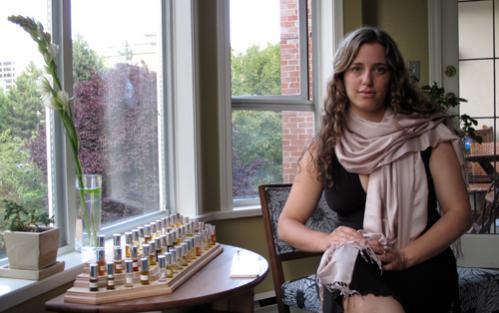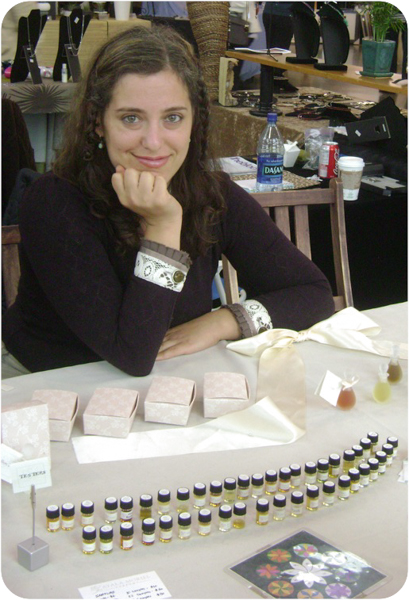I am happy to meet (virtually) Ayala Moriel, the owner the nose of perfume house Ayala Moriel Parfums. Inspired by fine art, music, and childhood memories of lush landscapes of Israel, Ayala creates unique, beautifully handcrafted fragrances using all-natural materials. Ayala’s collection includes more than 50 perfumes which brings joy to others through the sense of smell and also new emotional and intellectual impressions.

[wb_fb_f name=»Ayala Moriel» id=»»], picture was taken by Trish Vawter of http://ScentHive.com
Other than amazing perfumes Ayala makes beautifully scented candles and sachets, soaps, body oils, and also a wide range of scented teas, chocolates and truffles. Ayala Moriel perfumes enriches me, and my understanding of natural perfumes has acquired new dimensions. And I was certainly delighted to speak with Ayala about art of perfumery, inspiration and ingredients. Every perfume Ayala Moriel Parfums will be reviewed separately . And then I would like to share the joy with you – at the end of reviews, there will be a lottery the prize will be a set of perfumes samples.
And now — interview! (Russian version here) My text — in italic.
Ayala, while creating a certain perfume and thinking of the ingredients — do you usually have an abstract idea, that give you a lead, or the starting point is a fragrance ingredient, you are fascinated with?
Ayala: Just as each perfume tells a different story – the inspiration is also different. I don’t usually begin with the raw materials, but with an abstract concept – dynamic movement and interaction between the different materials and personalities within the perfume is what is perhaps the most significant thread in my work.
Although I have created certain perfumes around a particular raw material (i.e.: Vetiver Racinettes, my newest perfume Treazon, and my soliflore collection. I do not find this approach to be very intriguing as a general rule. Although it brought me to know these particular essences on a very intimate level — it’s more technical and tedious approach, very limiting creatively and not how I created my most innovative fragrances.
How I do create most of the time is by intuitively associating different notes with the personalities or forces that are at play in the olfactory story that I want to tell. Sometimes it would illustrate a natural or urban landscape (i.e.: Orcas and New Orleans), and other times it would portray my emotional reaction to a poem and the sensory and olfactory associations that came up when I read it (i.e.: Hanami). Others are focused on an internal journey (i.e.: Immortelle l’Amour, Schizm).
I know that your perfume l’Écume des Jours was inspired by Boris Vian’s novel.
Ayala: Yes, it id right. And another Boris Vian’s novel, l’Herbe Rouge, inspired me to create a fougere of that name. Essentially, each of my perfumes is a story, told through unique botanicals and that you can “read with your nose” and listen to with your heart.
My stories are rather personal ones. When I create perfumes, I travel deeply inwards to unearth ineffable emotions. Those stories can only be told by subtle engaging the wearer’s on a private, subconscious level.
And another question about l’Écume des Jours , which amazed me. When I tried your l’Écume des Jours in Moscow, I thought that this perfume would better reveal itself on the seaside.
Ayala: l’Écume des Jours evokes the sea’s salty breeze, but also aquatic vegetation and flowers. I don’t think that being near these environments is essential for enjoying the perfumer though. This has more to do with the wearer’s mood and emotional disposition.

What do you think about the correlation of climate and scents?
Ayala: The climate, weather and season, however, all have a lot influence on how perfumes travels in the air (amplifying them or not so much), as well as on people’s moods – and therefore , not surprisingly – perfume choices. Humidity really opens up the scent, and if it’s hot and humid, it can be overbearing. Extremely dry weather doesn’t really let the perfume travel as well. And I also learned that altitude has an impact on how perfume is experienced. But I haven’t been to extremely high altitudes yet to comment from my personal experience.
When I visit in Israel I can hardly tolerate heavy orientals and heady florals, and tend to wear lighter citrus and sheer, bright floral fragrances. When it’s really hot and humid, I want to wear nothing at all. The climate in Vancouver is very temperate and rather monotonous, so perfumes provide a wonderful escapism from all the greyness and rain.
Ayala, let’s talk about ingredients. I discovered for myself Ruh Chameli, Ruh Juhi, Ruh Motia — traditional distillation of Jasmine flowers in copper deg vessels from White Lotus shop last year. These extraordinary and expensive ingredients totally changed the regular image of jasmine scents. Also I absolutely love oil from Aquilaria wood and now I have 10 kinds of extracts and I like that they are all different. Could you tell us about your collection of rare and precious components?
Ayala: I was obsessed with various vetiver extractions, which is how Vetiver Racinettes came about. I used to not enjoy vetiver at all – probably because the only oil I was exposed to was a poor quality. I have anything from vetiver ruh (traditional Indian distillation in copper stills), vetiver co2 from South Africa and my most favourites – Haitian vetiver, with its distinctively clean wet wood and citrus scent, and even the most hard to find Bourbon vetiver, which is smoky and rich, almost nutty.
I love boronia, which is a rather difficult to source essence (the demand is far greater than the supply) and a few white water lily and blue lotus essences and attars, which I’m always worried about using because I have so little of them. I save most of these rare essences for custom perfumes or for my own personal experimentation, because they are so difficult to find (not to mention expensive).
I know how important it is for my customers to be able to enjoy the perfumes they fell in love with time and again; therefore I prefer to formulate my collection around essences that I can steadily source again. This enables me to have a rather reliable line that my customers can count on being there for them when their bottles run out.
Yes, unfortunately in our work we are limited to availability of some ingredients. But on the other hand that makes natural perfumes even more unique and precious. For instance despite the fact I love Indian attars, mitty, ambery, katsuri attars, I have to use them only for my limited collections, for they aren’t up for sale all the time. Speaking about attars, do you use them?
Ayala: Some of the attars are complete perfumes on their own, and I feel it’s wrong for me to use them in my formulas. It would be like using someone else’s bases. I use some attars that are single note, i.e.: Kadam tree attar in Hanami, and Kewda attar in GiGi and Charisma. Kewda is very difficult to find as a pure essential oil and it’s so volatile that the sandalwood base provides a wonderful fixative for it.
End of part 1 (Russian version here)
[Facebook_Comments_Widget title=»» appId=»» href=»» numPosts=»5″ width=»470″ color=»dark» code=»html5″ ]